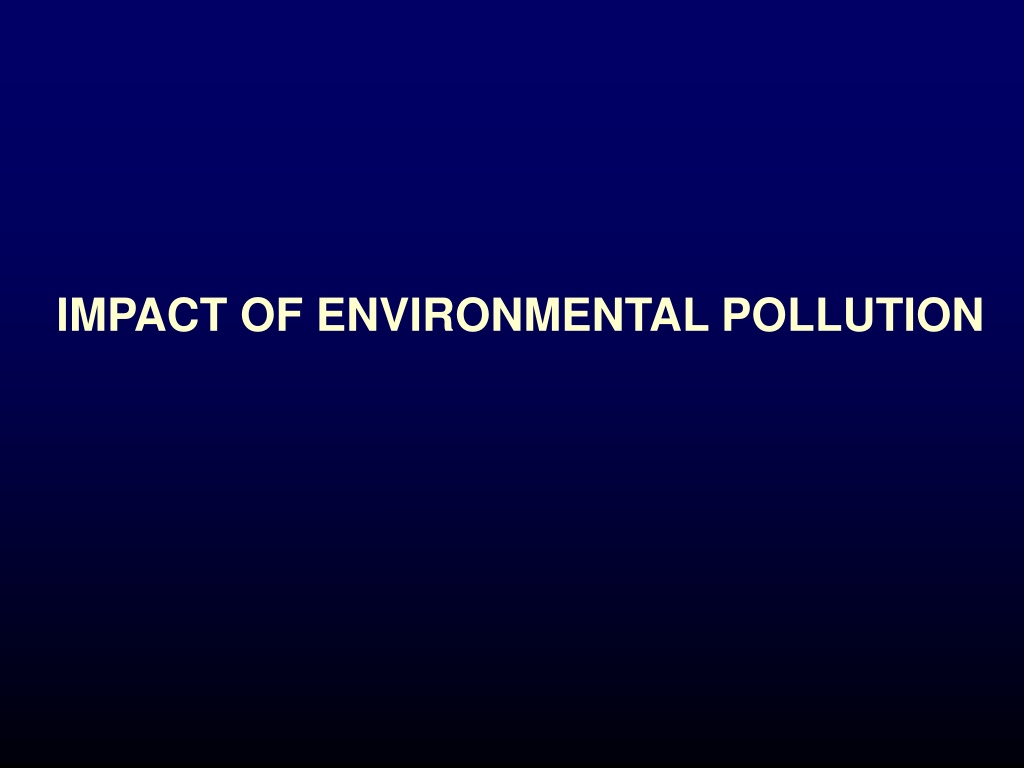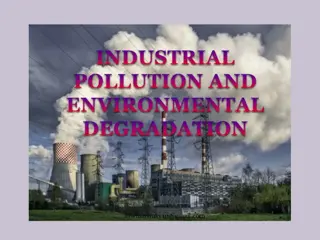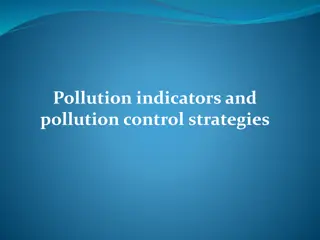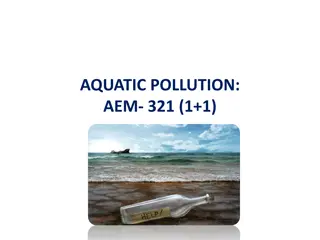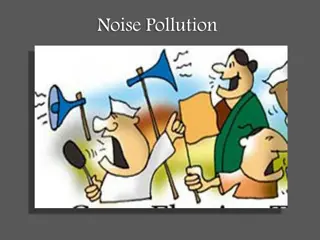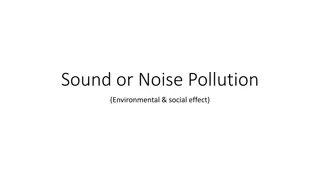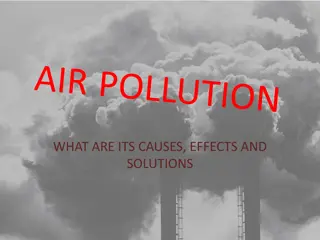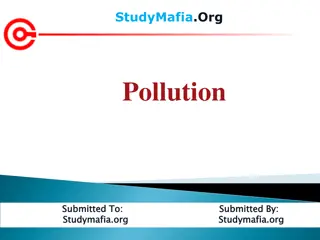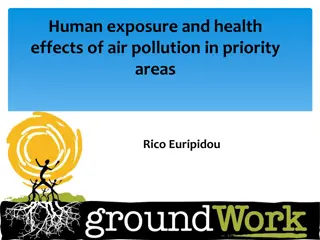Understanding the Impact of Environmental Pollution on Human Health
Environmental pollution, including air, water, soil, and waste pollution, poses serious threats to ecosystems and human health. Air pollutants like particulate matter can lead to respiratory issues, while smog, a combination of smoke and fog, creates urban air quality problems. Different types of smog, such as photochemical smog in Los Angeles, are linked to vehicle emissions and industrial activities. It's crucial to address pollution to mitigate its harmful effects and protect both the environment and public health.
Download Presentation

Please find below an Image/Link to download the presentation.
The content on the website is provided AS IS for your information and personal use only. It may not be sold, licensed, or shared on other websites without obtaining consent from the author. Download presentation by click this link. If you encounter any issues during the download, it is possible that the publisher has removed the file from their server.
E N D
Presentation Transcript
Pollution Definition Any undesirable change in physical , chemical or biological characteristics of air , land , water Pollution is the introduction of contaminants into an environment that causes instability, disorder, harm or discomfort to the ecosystem i.e. physical systems or living organisms. Pollution can take the form of chemical substances or energy, such as noise, heat, or light. ...
Pollution Air Pollution Water Pollution Soil Pollution Waste production
AIR POLLUTION Sources Combustion of fuel (natural gas, petroleum, coal and wood) Industrial process Natural process (Volcanic)
Air Pollutants and its impact on human health Particulate Matter Dust and smoke particles cause irritation of the respiratory tract and produce bronchitis, asthma and lung diseases. Dust and smoke function as nuclei for condensation of water vapors and produce smog which attract chemicals like SO2, H2S, NO2,etc. Smog not only reduce visibility but is also harmful due to its contained chemicals.
SMOG Smog is the combination of smoke and fog. It is a man made air pollutant in urban areas. The term smog was coined by H.A.Des Voeux http://keetsa.com/blog/pollution/now-japan-has-smog-problems/
Types of Smog Photochemical Smog http://www.dailymail.co.uk/health/article-559685/Air-pollution-kills-smogs-1950s-say-scientists.html
Los Angeles Smog Photochemically- produced Associated with motor vehicle emissions Brown in color
Los Angeles Smog Los Angeles Smog: driven by the photochemistry of the volatile organic compounds (VOCs) and oxygenated nitrogen species (NOx) contained in exhaust from combustion engines. Photochemical smog is air saturated with ozone, VOCs and aerosol particles.
Industrial smog The gray air in industrial cities in cold winter areas, caused from burning fossil fuel. Industrial smog is in the forms of dust, smoke, soot, ashes, asbestos, oil, lead, heavy metals, and sulfur oxides. In 1952, industrial smog held in place by a thermal inversion caused the 4,000 deaths in London.
Industrial Smog London Smog London smog: fog soot particles sulfur dioxide tar This forms a highly acidic mist. Some incidents of deaths associated with sulfurous smog: 1930 Meuse Valley, Belgium 63 1948 Donora, Pennsylvania 20 1952 London (5 days) 4000 1962 London 700 These deaths lead to a reduction in coal consumption and an increase in alternative fuels, such as gasoline...
DUSTS (Pneumoconiosis) Inorganic Dust Coal Dust - Anthracosis Silica - Silicosis Asbestos - Asbestosis Iron - Siderosis Organic Dusts Cane Fiber - Bagassosis (Bronchi gets affected) Cotton dust - Byssinosis (In Textile industries) Tobacco - Tobaccosis, Lung Cancer Grain Dust - Farmer s Lungs
Asbestos - Asbestosis Iron- Siderosis The iris has the " rusty " appearance that results from siderosis.
Pneumoconiosis A disease of the lungs characterized by fibrosis and caused by the chronic inhalation of mineral dusts, especially silica and asbestos. When Insoluble Inorganic Material (like silica and asbestos) enters the lungs, they stay in the lungs and cause inflammation and disease
Oxides of Nitrogen - Brochiolitis They cause eye irritation and respiratory trouble. They have mutagenic properties
Sulphur dioxide COPD,Asthma COPD - diseases of the lungs in which the airways become narrowed
Carbon Monoxide It is formed by incomplete combustion of carbon fuels in various industries , motor vehicles, hearths,etc. It causes impairment of judgment and vision, headache and dizziness. Sulphur Dioxide It is produced in large quantity during smelting of metallic ores. It causes trachial irritation, cough, bronchial spasms.
Chlorine It is present in volcanic eruptions and emitted in processes involving use of chlorinated chemicals. It causes eye and respiratory ailments. Chlorine rising up in the atmosphere poses danger to ozone layer.
WATER POLLUTION Water Facts Only about 3% of surface water is fresh water One-fifth of the world population lack access to clean drinking water Over 2.6 billion people do not have adequate toilets, sewers or latrines Water-borne Diseases : o Affect four billion people every year o Kill five million people including 6000 children every year
oo More than 2 million children are killed by diarrhoeal diseases each year o Earth s oceans are the most important carbon sink on the planet along with rain forests o Demand for water will double in next 30 years o Floods are most frequent disaster worldwide
World Water Demand/Year 1940 1000 km3 1990 4130 km3 2000 5000 km3 2002 6650 km3 2020 9000 km3
WATER POLLUTION Sources and impacts Domestic wastes and sewage -- Sewage of municipalities, boats, ships, etc. It causes depletion of oxygen It produce foul odour and makes the water oily and brownish. Increase the sludge which make the water unfit for recreational and industrial use, It induces the growth of algal blooms.
Surface Run-off -- The pollutants present on the surface of land and fertilizers are washed down into water bodies. The nitrites enter the blood and combine with hemoglobin to form methaemoglobin. The latter is unable to transport oxygen and gives rise to disease called as methaemoglobinaemia. Infants are the most affected, showing signs of blueness around the mouth, hands and feet, having trouble breathing as well as vomiting and diarrhoea.
Industrial Effluents They are industrial wastes which are either dumped in the soil or are allowed to pass into water bodies. The effluents contains heavy metals, cyanides, thicynates, chromates, acids, alkalies, organic solvent,etc. Mercury sources ; Coal, smelting of ores, paper/paint industry Mercury causes Minamata disease. Minamata disease is the name given to mercury (poisoning) that developed in people who ate contaminated sea food taken from Minamata Bay toxicosis The disease results in crippling deformity
Sources of lead pollution Paints, smelters, chemical and pesticide industries, petrochemicals. Lead poisoning (also known as plumbism, colica pictonium, saturnism, painter's colic) is a medical condition caused by increased levels of the heavy metal lead in the body. Lead interferes with a variety of body processes and is toxic to many organs and tissues including the heart, bones, intestines, kidneys, reproductive and nervous systems.
Cadmium Pollution Sources ; Smelting and refining of metals, or from the air in plants that make cadmium products such as batteries, coatings, or plastics .Cigarettes are also a significant source of cadmium exposureCadmium is used in industry as a protective coat for iron, copper and steel Ex; telephone wires. Paint pigments Cadmium causes renal damage, emphysema and hypertension and Itai-Itai diseases.
Symptoms One of the main effects of cadmium poisoning is weak and brittle bones. Spinal and leg pain is common, and a waddling gait often develops due to bone deformities caused by the cadmium. The pain eventually becomes debilitating, with fractures becoming more common as the bone weakens. Other complications include coughing, anemia, and kidney failure, leading to death Effects Effects seen on liver and kidney mainly. Organs of toxicity:- Central Nervous System, Kidney .
Amoebiasis Amoebiasis, sometimes spelt amebiasis, is one of those common diseases, caused by a parasite which infects the bowel casing a type of gastroenteritis infection. This disease generally occurs in young to middle aged adults who ingest contaminated food or water containing the Entamoeba histolytica microorganism
Giardiasis Giardiasis (gee-ar-die-a-sis with a soft "G") is an infection of the small intestine that is caused by the parasite, Giardia lamblia The most common manifestations of giardiasis are diarrhoea and abdominal pain, particularly cramping; however, diarrhea is not invariable and occurs in 60% to 90% of patients
Nuclear pollution The source of nuclear pollution are weapon testing, atomic power plants, recycling plants, nuclear wastes, etc. It causes blood and bone cancer It disrupts normal functioning of thyroid, and consequently produces abnormal growth and metabolism The consequence of two bomb blasts over Hiroshima and Nagasaki (JAPAN) still send waves of tremor in us. Innumerable persons died. The survivors not only suffered themselves but also passed to their offspring malignant growth , cancer, congenital deformities, mental retardation, etc.
Pesticides They are discharged to the water body through the agricultural run-off. Chlorinated Hydrocarbon, organo pesticides and inorganic pesticides are poisonous and causes sweating, salivation, nausea, vomiting , diarrhoea and muscular tremors for the people Chromium has carcinogenic properties. Nickel can cause damage to liver and kidney. Arsenic can cause hyper-pigmentation, Keratosis and black foot disease
Fluoride Pollution 96 % of fluoride is found in bones and teeth. Fluorine is essential for the normal mineralization of bones and formation of dental enamel. Water resources near granitic rocks containing more than 2.5 ppm cause Fluorosis The cause of this diseases mainly due to consumption of high quantity of fluoride through water, food, cosmetic like fluoridated tooth paste, drugs and inhaling air contaminated with fluoride in industrial environment.
Fluorosis was first detected in India among cattle by the farmers of Andhra pradesh State during early 1930. The farmers noticed the inability of the bullocks to walk due to painfull and stiff joints. This endemic fluorosis had been identified in total 15 state of the Indian union. Fluorosis is a clinical condition recognized by Shrott in 1937 . kennedy02
NOISE POLLUTION The term noise is applied to the sound that cause irritation on hearing of healthy human being. Sources Transport noise--- Originates from road traffic (vehicular), air craft and rail traffic. Industrial noise--- It produced by presses; punch and stamp machine, pneumatic drills, milling machines, cutter and routers, dust extractors. etc. Domestic noise--- It is generated from domestic appliance like washing machines, spin dryers, food mixer, sink waste grinder and vacuum cleaner.
Effects Of Noise Pollution Hearing damage from noise exposure Pathological and Physiological disorders The impact of noise may cause permanent hearing loss due to the exposure to noise levels exceeding 90 dB
SOLID WASTE Urban India produces 1,20,000 tons of MSW/Day. Per capita waste generation in major cities of India ranges from 0.8 kg to 1.0 kg per day. Of the MSW collected; 94% is dumped on land and 5% is composed. 23 metrocities generates 30,000 tons of SW/Day. Class-I cities generate 50,000 tons of solid waste per day Karnataka State generates 3553.97 tons/Day , disposes 2848.05 tons/Day and the remaining is un collected wastes.
Sources Municipal Wastes Agricultural Wastes And Sewage Sludge Industrial Wastes and Mining Wastes Bio-Medical Wastes E-Wastes Radioactive Wastes
Effects of Solid Wastes Pollute ground water Waste becomes storehouses for pathogens Bag pickers affected by skin diseases, respiratory tract infections, stomach infections, eye irritation, etc. Dumping helps the breeding of mosquitoes Burning releases furans (Chlorinated Carbons) which reduces the fertility of human. Hazardous substances include mercury, chromium, etc Bioaccumulation Accumulation of copper in soil inhibit plant growth.
